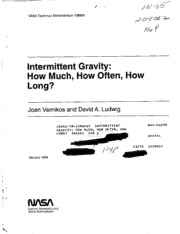
NASA Technical Reports Server (NTRS) 19940021595: Intermittent gravity: How much, how often, how long? PDF
Preview NASA Technical Reports Server (NTRS) 19940021595: Intermittent gravity: How much, how often, how long?
f ,f IA/-_© NASA Technical Memorandum 108800 Intermittent Gravity: How Much, How Often, How Long? Joan Vernikos and David A. Ludwig (NASA-TM-I08800) INTERMITTENT N94-26098 GRAVITY: HOW MUCH, HOW OFTEN, HOW LONG? (NASA) 106 p Unclas G3/55 0209002 January 1994 # 7 NASA National Aeronautics and Space Administration i | NASA Technical Memorandum 108800 Intermittent Gravity: How Much, How Often, How Long? Joan Vernikos, Ames Research Center, Moffett Field, California David A. Ludwig, University of North Carolina, Greensboro, North Carolina January 1994 NationalAeronautics and Space Administration Ames Research Center Moffett Field,California94035-1000 ,f Table of Contents Page Preface ................................................................................................................................................................. vii Glossary ............................................................................................................................................................... Summary .............................................................................................................................................................. Introduction .......................................................................................................................................................... 3 Methods ............................................................................................................................................................... 3 Subjects ........................................................................................................................................................ 4 Table 1. Control data from tests before HDBR exposures .............................................................. 4 Treatments and Experimental Protocol ........................................................................................................ 4 Table 2. Five treatment conditions .................................................................................................. 4 Experimental Conditions .............................................................................................................................. 5 Experimental Procedures .............................................................................................................................. 5 Blood Samples .............................................................................................................................................. 5 Urine Samples .............................................................................................................................................. 5 Tilt Tolerance Test ....................................................................................................................................... 6 Peak Oxygen Consumption Test .................................................................................................................. 6 Plasma Volume ............................................................................................................................................ 7 Blood Analyses ............................................................................................................................................ Urine Analyses ............................................................................................................................................. Statistics ........................................................................................................................................................ Statistics: orthostatic tolerance .............................................................................................................. 8 Results .................................................................................................................................................................. 8 Orthostatic Tolerance: Heart Rate and Blood Pressure ................................................................................ 9 Figure I. Heart rate response to 60° head-up tilt by treatment conditions ........................................ 10 Figure 2. Mean arterial pressure response to 60° head-up tilt by treatment conditions .................... II Figure 3. Systolic blood pressure response to 60°head-up tilt by treatment conditions .................. 12 Figure 4. Diastolic blood pressure response to 60° head-up tilt by treatment conditions ................ 13 Heart Rate Responses ............................................................................................................................ 13 Mean Arterial Pressure Responses ........................................................................................................ 13 Systolic Blood Pressure and Diastolic Blood Pressure Responses ....................................................... 13 Orthostatic Tolerance: Syncope Prevalence .......................................................................................... 14 Figure 5. Tilt test survival rates by treatment conditions for pre- and post-HDBR measurements.. 15 Peak Oxygen Consumption ....................................... .................................................................................... 16 Figure 6. Pre- to post-HDBR differences in VO2pea k ............................................................................ 15 Plasma Volume ............................................................................................................................................ 17 Figure 7. Pre- to post-HDBR differences in plasma volume ............................................................ 15 Urinary Calcium ........................................................................................................................................... 18 Figure 8. Actual and predicted urinary calcium by treatment conditions and HDBR days .............. 19 Figure 9. Linear change in urinary calcium by treatment conditions during HDBR ........................ 20 Figure 10. Quadratic change in urinary calcium by treatment conditions during HDBR .................. 21 Conclusions .......................................................................................................................................................... 21 Table 3. Summary of results ............................................................................................................ 22 References ..................................................................... _............................................................................ _......... 25 Appendix: Data Tables ........................................................................................................................................ _ pI_-C, K43_ G PA_E BLANK NOT FtLt_o w,_¢ "__ INTENTIONALLY B_\I'_ _..-- _ 2_ I III pr_,.,,- Preface This technical memorandum is a compilation of the results of a 4-day head-down bed rest (HDBR) study. This study was designed to investigate the effects of 4days of HDBR alone or with 2or 4hours of standing or walking intermittently during each day of HDBR on orthostatic tolerance, maintenance of working capacity (peak oxygen uptake), calcium excretion, and endocrine and fluid and electrolyte responses. The following investigators participated: A. C. Ertl, Ph.D., C. E. Wade, Ph.D., L. Keil, Ph.D., J. E. Greenleaf, Ph.D., and D. O'Hara, R.N., NASA Ames Research Center, Moffett Field, CA 94035-1000. In addition, M. R. Duvoisin, Ph.D., and J. L. Stinn, Ph.D., Biomedical Operations and Research Office, NASA Kennedy Space Center, FL 32899, were instrumental in developing the software for the monitoring and recording of continuous cardiovascular data during the orthostatic tests and St. J. Maloney and V. Reyna for data analyses and compilation of this document. Portions of this report were funded by NASA Ames Research Center Consortium Agreement #NCA2-629. Joan Vernikos, Ph.D. Chief (Acting) Life Science Division NASA Ames Research Center Moffett Field, California David A. Ludwig, Ph.D. Associate Professor of Mathematics and Statistics University of North Carolina Greensboro, North Carolina I:_I_CZID, I_i_ PAGE f_;t.A{ll_, N(J3 F.ILI_,_L-*TE 1,_NTI0i,!AU Y " _, :! 2 HR heart rate Glossary ANCOVA analysis of covariance HRF Human Research Facility ANOVA analysis of variance ISE ion specific electrode ANP atrial natriuretic peptide K potassium APA alkaline picric acid LBNP lower body negative pressure AVP arginine vasopressin LDL low density lipoprotein BP blood pressure MAP mean arterial pressure Na sodium bpm beats per minute BR bed rest NE norepinephrine BV blood volume NF non-fainter during tilt test C ambulatory control P probability value Ca calcium PRA plasma renin activity DBP diastolic blood pressure PV plasma volume E epinephrine RIA radioimmunoassay F fainter during tilt test S standing condition (e.g., $4, standing for 4hours) G gravity SBP systolic blood pressure Gz gravity in head-to-toe vector SD standard deviation GFR glomerular filtration rate SE standard error Hct hematocrit VO2pea k peak oxygen consumption HDBR head-down bed rest W walking condition (e.g., W4, walking HDL high density lipoprotein for 4hours) r<. trK B#__9 :pAGE.-V.::y.._..L.._. .. 2
